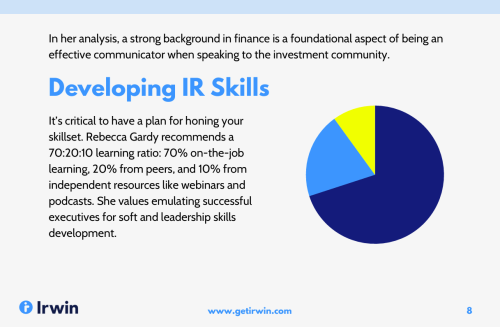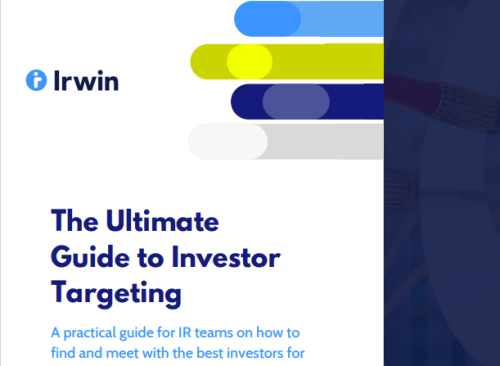The investor relations profession was up against a near infinite set of challenges in 2022: depressed investor sentiment, coping with the pressures of digital transformation, mapping out a post-Covid comeback and navigating a rapidly changing market environment. We’re examining some of the most pressing issues for today’s IR professionals and how we overcame them.
Managing investor expectations
Share prices bear the brunt in a turbulent market, putting a greater emphasis on keeping investors’ expectations realistic and spirits high. Investors look to the CEO – and the IR team – for reassurance that the business remains healthy, management is in control and plans for continued success are in place.

In many ways, this provided an opportunity to focus on the fundamentals of the business and revisit corporate strategy and messaging with the investment community. In 2022, we saw more authentic storytelling and a greater emphasis on transparency in disclosures and communications: earnings calls, CEO letters and investor presentations. IROs spent an increased amount of time having these candid conversations, nurturing investor relationships and communicating how the company intends to grow in adverse market conditions.
Show me the money!
Raising capital has never been so challenging. We witnessed the rise of the retail investor over the past several years and watch as they now sit on the sidelines. The public equity markets are supposed to make it easier for a company to access capital but diluting shareholders at depressed share levels was a hot topic of conversation in many boardrooms around the globe.
IR professionals shifted their focus to nurturing existing investor relationships, pivoting targets to keep long-term investments. Creativity and hustle were applied like never before to broaden investor support and access capital in new markets.
Shifting shareholder base
A shifting shareholder base has the potential to add risk to a company’s stock price performance. The year 2022 saw index fund changes, adding and dropping companies based on a predefined set of criteria. Institutions reduced their positions, sometimes without warning or explanation.

Retail has a greater tendency to make emotion-based decisions and, even if you were a 2022 outperformer, your shareholder base may have shifted as investors took their gains to offset their losses. In a down-market, there is a greater chance of investors accumulating meaningful ownership positions to take an activist approach to monetizing their investment.
IROs needed to be hyper-aware of their shareholder base by analyzing non-objecting beneficial owner lists and anonymous trading reports, and monitoring indices criteria, email unsubscribes and abnormal trading activity. Working closely with or bringing in a market maker helps with shareholder visibility.
Maintaining and gaining analyst coverage
Equity research is generally correlated with capital raising. Without an active financing environment, obtaining analyst coverage was extremely challenging this year. Furthermore, many banks dropped certain sectors or minimized their coverage universe due to limited resources, such as time and talent.
Keeping analysts engaged was a key focus of 2022: proactively inviting them to earnings calls and investor days, building a relationship by sharing industry insights and sharing company developments and news releases. It’s important to remember that analysts are in regular communication with investors so even if they don’t cover a particular company, they can still speak intelligently about it if asked by investors when IROs do their job right.
Making data-driven decisions in real time
Effectively leveraging and using data was both an opportunity and a challenge in 2022. From sentiment tools and website domain traffic to trade prediction platforms, keeping up with the flurry of tech tools that have erupted and how they impact investor relations was a challenge. AI tools such as Intro-act allowed us to predict institutional investors’ trades and their likelihood to buy/sell over the next 90 days.
Most IR professionals are in the ‘education’ or ‘discovery’ phases of using these platforms. Understanding the landscape and the breadth of AI platforms that exist for both investors and issuers played a big industry role in 2022. Knowing when an institutional investor will sell your stock and being able to get ahead was integral to help manage the trade.
When it comes to data and AI platforms, it’s easy to get overwhelmed and lost in the diversity of options. Start by identifying the business questions you want to answer in order to achieve the goals of your IR program. Many IR teams brought in data analysts in 2022 and we expect this trend to continue in the coming years.
Do more with less
Many IROs have been around for several market cycles so they are accustomed to budget cuts. The year 2022 was a focus on efficiency and doing more with less. For many, this included a robust IR program at a fraction of the cost and, for some, a reduction in personnel. IROs have always been multi-talented, acting as writers, analysts, strategists, governance gurus, graphic designers, social media experts, media relations experts, project managers and a trusted right hand to the C-suite.
‘Lead gen’
The most-used phrase in the IR dictionary for 2022. Everyone wants to attract qualified investors and we’re with you! Generating leads through website forms, optimizing SEO, launching digital marketing campaigns with landing pages and strategically placing opt-in forms, IR teams expanded their knowledge and skillsets to draw in more investors in 2022.
What have you done for me lately?
In the best of times, IR is not for the faint of heart. It’s an all-consuming career that requires a dynamic set of skills and knowledge. Proving the value of your IR efforts is extremely challenging in a down-market, but we overcame this in 2022 by maintaining good communication and trust with the C-suite. Capturing changes in shareholder positions, lead-gen statistics, commentary around relationship-building with analysts and more, we can see the clear impact of IR in concrete numbers and continued business growth through what has been one of the toughest years in our industry.
Final thoughts
Investor relations has always been a challenging role within any organization – between the rising expectations from the C-suite and the pressure to keep pace with the rapid rate of change, it’s unlikely this demanding career will get easier in the near future, if ever. Undoubtedly, IR is one of the most rewarding positions within any organization, with the greatest access to management and the board and the ability to help shape the future of a company. That said, navigating this ambitious landscape doesn’t need to be overwhelming. With the right tools, skills and teams, IROs have a rare opportunity to position themselves for future wins and lasting success.
Alyssa Barry is a principal and co-founder and Todd Skene is director of capital markets at irlabs











